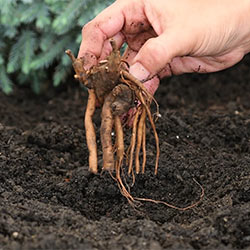Thank You!
We have received your request. You will be notified when this product is in stock.
X
When not in bloom, their lush, dark green glossy foliage lends a tropical aura to beds and borders. Our selection of lovely calla lily bulbs for sale includes a colorful mix of several vibrant varieties, all of which produce a wealth of distinctive trumpet-shaped fragrant blooms. While white calla lilies have the strongest scent, most callas have a soft, sweet floral aroma. Shop calla lily bulbs for sale now, so you can expand your garden.
How to grow calla lilies:
Calla lilies make a beautiful addition to flower beds and borders, and can even be grown in containers. However, these rhizomatous flowers grow a bit differently than true lilies. So, how do you grow calla lilies at home?
Zantedeschia, or calla lilies, can be grown as perennials in warmer climates, such as grow zones 8 through 10. In cooler climates, you can grow calla lilies as annuals, or you can dig and store your calla lily bulbs over the winter. Calla rhizomes tend to go dormant at temperatures below 50 degrees fahrenheit.
Calla lilies are surprisingly easy to grow, especially if you choose a good growing location. These plants require well-drained, loose soil and lots of sun. Callas lilies are tolerant of full sun in cooler climates and part shade in warmer ones. The Calla's absolute favorite setting, though, is dappled light with humidity and heat. Calla lilies are true tropicals!
Calla lily bulbs are typically planted in the spring after the threat of frost has passed. They should be placed in well-drained soil after it reaches about 65 degrees and about twelve inches apart and four inches deep. Once you've set your calla lily rhizomes in the ground, be sure to water regularly, keeping the ground (or potting soil if in containers) evenly moist, but not soggy. Adding a phosphorus-rich fertilizer about every two weeks will help your Calla lilies grow tall and encourage bigger blooms. Too much nitrogen can encourage leafy growth, and may detract from your calla lilies' blooms.
When the calla lilies' blooms fade in autumn, cease fertilizing, and cut back on your watering schedule. You should also trim back the faded flowers, to let the bulbs store energy for next year's blooms. If you are in the warmer zones, 8-10, your callas can stay in the ground and will enter a period of winter dormancy on their own. If you're gardening in a cooler climate, you'll need to dig and store the calla lily rhizomes every fall. In warmer zones, calla lilies are much more "set and forget":—you need only divide the rhizomes every few years to prevent overcrowding.
Calla lilies grow one to two feet tall, but do not need staked. Is your calla lily drooping? It may be a sign of overwatering, a bulb experiencing rot or a fungal infection. You may need to dig the bulb and start over. Too heavy of nitrogen in your soil will cause your calla lily to produce more foliage than flowers—remember Callas prefer a phosphorus rich soil.
When to plant calla lily bulbs:
Call lilies should be planted in the spring, after all the threat of frost has passed for your garden. This rule applies for both "fresh" rhizomes and overwintered bulbs: callas generally shouldn't go into soil that is below 65 degrees or so.
Calla lilies can be started indoors, in pots, about a month before transferring them outdoors—this is the key for gardeners living in climates that remain cooler longer! Some florists, or home gardeners, love to use callas in Easter arrangements. If you want to plant callas in time for Easter cuttings, start them indoors just after Christmas.
Where to plant calla lilies' bulbs:
Calla lilies really thrive in partial shade, morning sun, or dappled light: they definitely need some sunshine, but harsh sunlight in the heat of the afternoon can scorch them. Choose a location that has loose, well-draining soil and morning or scattered light. Because calla lilies are so tall plants, they can provide a beautiful vertical accent clustered in a big bed, or set behind lower flowers. They're also excellent border blooms. Calla lilies can also be grown in planters, barrels or containers—and, growing them in pots can make callas easier to overwinter in temperate climates.
How to plant calla lily bulbs:
After the last frost, it's time to plant your Calla lilies! Choose the right spot to plant your calla lilies by selecting an area with loamy soil and dappled or morning sunlight. They should be planted about twelve inches apart and four inches deep. Plant your calla rhizomes with the growing tip faces up and about four inches deep and 12 inches apart, then water as needed to keep the ground evenly moist —callas are predisposed to rot, and too much watering can be harmful.
When do calla lilies bloom?
Calla lily plants are long-blooming flowers, and may flower for three to eight weeks in the summer and fall. In temperate climates, calla lily bulbs may be planted outdoors after the final freeze of the year, and will bloom 13-16 weeks later.
Calla lilies can also be forced to bloom indoors. To get your calla lily to bloom indoors, you must first allow it to go bone dry once it finishes its current bloom period. When the foliage dies back and the calla appears dead, place it in a cool (not cold) dark area for about 2 months. You can now bring your calla out into the light and begin watering it again, the foliage will regrow and the calla lily will bloom again.
How to store calla lily bulbs:
If you're gardening in Zones 3 to 7, you'll need to overwinter your calla lilies indoors. Callas don't respond well to freezing conditions, and even a single, leaf-damaging frost makes the plant unlikely to pop back up come springtime.
If you're growing callas indoors, you'll simply need to slow their watering and fertilization schedule: let them dry out, and store the containers in a cool and dry place through the winter months. In late February, re-start the watering and fertilization routine, and consider repotting your calla lilies.
If you'd like to grow your callas in the ground, you'll need to lift and store the calla lily rhizomes after the flowers are done blooming. Unlike Asiatic or Oriental lilies—what we think of as "true lilies" —callas are grown from rhizomes, not bulbs, and these rhizomes are sensitive to cold weather and other indignities. To lift the bulbs, tug on the stems to pull them out of the ground -- the stems can be clipped, or will wilt and fall off. Allow the bulbs to dry 2-3 days before storing; now, place them in a box with barely damp peat moss and store them in a dark location at 50-60 degrees. Check the bulbs, throughout the winter, to be sure they are not too dry or too wet.
How to grow calla lilies indoors:
Calla lilies are a florist favorite—especially for weddings and springtime holidays -- and make beautiful houseplants! In order to grow calla lilies indoors, you'll need to pot the rhizomes in a loose, well-draining, and rich soil. Calla lilies will dry out more quickly in pots than in the ground, so water these houseplants frequently, but be sure the soil doesn't get soggy. Fertilize them with a controlled release fertilizer throughout the growing months.
Once the blooming season is over in the fall, quit fertilizing and slow your watering schedule. The plants will require a few weeks of dormancy, so let them dry out and rest. Then, in the early spring, repot the calla lily bulbs with fresh soil and begin watering. Springtime is a great time to ensure your calla lilies aren't root bound —transfer them to a larger pot, and gently break up any tangled or twisted roots.






















